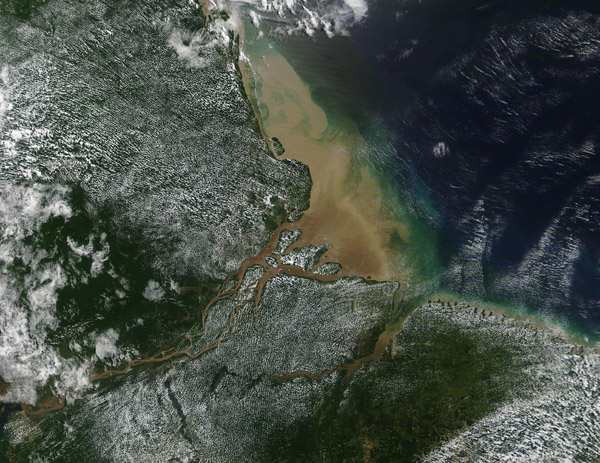Images
August 7, 2020 - Amazon River Delta
Tweet
The Amazon River is the world’s largest river, springing from tiny glacier-fed streams in the Andes Mountains and winding more than 4,049 miles (6,516 km) across the continent to reach the Atlantic Ocean.
Approximately 7,740,000 cubic feet (219 cubic meters) – roughly equivalent of 88 Olympic-size swimming pools – flow from the river into the Atlantic Ocean every second. As this rapid rush of water sweeps through the Amazon Rainforest, it picks up soil and minerals, ultimately dumping them into the equatorial Atlantic Ocean. The huge influx of nutrients has an enormous impact on life in the Atlantic Ocean. Nutrients from the plume feed microscopic, surface-dwelling, ocean plants (phytoplankton), which in turn feed a diverse population of fish.
On August 3, 2020, the Moderate Resolution Imaging Spectroradiometer (MODIS) on board NASA’s Terra satellite acquired a true-color image of the Amazon River Delta, where the river meets the Atlantic Ocean.
Muddy brown sediment spills into the deep blue ocean water, creating a plume that spreads northward. Near the surface, sediment appears dark brown and, as it sinks, the appearance changes first to light brown then to green. The dark greens on land mark areas of heavy vegetation – primarily Amazon rainforest. Numerous “popcorn” clouds float above the forest. This type of cloud is formed by condensed water vapor released by plants and trees during a sunny day and is common over the lush, moist vegetation of the Amazon rainforest.
Image Facts
Satellite:
Terra
Date Acquired: 8/3/2020
Resolutions:
1km (497.1 KB), 500m (1.5 MB), 250m (3.2 MB)
Bands Used: 1,4,3
Image Credit:
MODIS Land Rapid Response Team, NASA GSFC
Tweet
The Amazon River is the world’s largest river, springing from tiny glacier-fed streams in the Andes Mountains and winding more than 4,049 miles (6,516 km) across the continent to reach the Atlantic Ocean.
Approximately 7,740,000 cubic feet (219 cubic meters) – roughly equivalent of 88 Olympic-size swimming pools – flow from the river into the Atlantic Ocean every second. As this rapid rush of water sweeps through the Amazon Rainforest, it picks up soil and minerals, ultimately dumping them into the equatorial Atlantic Ocean. The huge influx of nutrients has an enormous impact on life in the Atlantic Ocean. Nutrients from the plume feed microscopic, surface-dwelling, ocean plants (phytoplankton), which in turn feed a diverse population of fish.
On August 3, 2020, the Moderate Resolution Imaging Spectroradiometer (MODIS) on board NASA’s Terra satellite acquired a true-color image of the Amazon River Delta, where the river meets the Atlantic Ocean. Muddy brown sediment spills into the deep blue ocean water, creating a plume that spreads northward. Near the surface, sediment appears dark brown and, as it sinks, the appearance changes first to light brown then to green. The dark greens on land mark areas of heavy vegetation – primarily Amazon rainforest. Numerous “popcorn” clouds float above the forest. This type of cloud is formed by condensed water vapor released by plants and trees during a sunny day and is common over the lush, moist vegetation of the Amazon rainforest.
Image Facts
Satellite:
Terra
Date Acquired: 8/3/2020
Resolutions:
1km (497.1 KB), 500m (1.5 MB), 250m (3.2 MB)
Bands Used: 1,4,3
Image Credit:
MODIS Land Rapid Response Team, NASA GSFC




